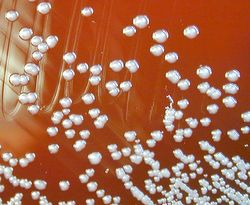Difference between revisions of "Burkholderia pseudomallei"
(Redirected page to Melioidosis) |
|||
| (6 intermediate revisions by 2 users not shown) | |||
| Line 1: | Line 1: | ||
| − | + | {{unfinished}} | |
| − | [[Category:Pseudomonas_and_Burkholderia_species | + | {| cellpadding="10" cellspacing="0" border="1" |
| + | | Also known as: | ||
| + | | ''B.pseudomallei'' | ||
| + | |- | ||
| + | |} | ||
| + | |||
| + | [[File:Burkholderia pseudo.jpg|right|thumb|250px|<small><center> Burkholderia pseudomallei colonies on a Blood agar plate.( Marco Tolo 2007, Wikimedia commons)</center></small>]] | ||
| + | |||
| + | ==Overview== | ||
| + | ''Burkholderia pseudomallei'' is a species of the ''[[Burkholderia species - Overview|Burkholderia]]'' genus. ''B.pseudomallei'' causes [[Melioidosis]], an opportunistic infection which is endemic in Asia and Australia. It primarily infects rodents. | ||
| + | |||
| + | ==Pathogenesis== | ||
| + | Infection occurs via ingestion, inhalation or via skin wounds from the environment. The bacteria contains an exotoxin, dermonecrotic protease and lecithinase which is implicated in pathogenicity. Strain virulence and host immunosuppression is important. ''Burkholderia pseudomallei'' is also motile, by polar flagellae. | ||
| + | |||
| + | ==Diagnosis== | ||
| + | Diagnosis of the ''B.pseudomallei'' bacteria can be made via specimens, including; pus from abscesses, affected tissues and blood. | ||
| + | The fluorescent antibody technique can be done on tissue smears. ''B.pseudomallei'' grows on blood agar and MacConkey agar plates, incubated aerobically. The colonies have a musty smell and you see lactose fermentation on MacConkey. Slide agglutination, ELISA, complement fixation and indirect haemagglutination tests for serum antibodies are also all diagnostic of ''B.pseudomallei.'' | ||
| + | |||
| + | [[Category:Pseudomonas_and_Burkholderia_species]] | ||
| + | |||
| + | [[Category:To_Do_-_AimeeHicks]] | ||
Revision as of 11:40, 26 July 2010
| This article is still under construction. |
| Also known as: | B.pseudomallei |
Overview
Burkholderia pseudomallei is a species of the Burkholderia genus. B.pseudomallei causes Melioidosis, an opportunistic infection which is endemic in Asia and Australia. It primarily infects rodents.
Pathogenesis
Infection occurs via ingestion, inhalation or via skin wounds from the environment. The bacteria contains an exotoxin, dermonecrotic protease and lecithinase which is implicated in pathogenicity. Strain virulence and host immunosuppression is important. Burkholderia pseudomallei is also motile, by polar flagellae.
Diagnosis
Diagnosis of the B.pseudomallei bacteria can be made via specimens, including; pus from abscesses, affected tissues and blood. The fluorescent antibody technique can be done on tissue smears. B.pseudomallei grows on blood agar and MacConkey agar plates, incubated aerobically. The colonies have a musty smell and you see lactose fermentation on MacConkey. Slide agglutination, ELISA, complement fixation and indirect haemagglutination tests for serum antibodies are also all diagnostic of B.pseudomallei.
